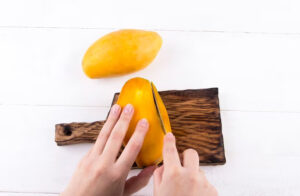Mango pickle, a delectable and tangy Indian condiment, is a beloved accompaniment to countless meals and snacks. Its mouthwatering blend of flavors, combined with the goodness of ripe mangoes and aromatic spices, makes it a cherished culinary delight. However, with a variety of brands and homemade options available in the market, choosing the perfect mango pickle can be a daunting task.
Purchasing dry mango pickle can be a delightful experience if you keep these tips in mind. From considering the ingredients and spice levels to supporting local artisans and exploring regional variations, you can enhance your culinary journey and savor the diverse flavors of this beloved Indian condiment. Whether you choose traditional recipes, homemade options, or innovative flavors, a well-chosen mango pickle will undoubtedly add a burst of delightful taste to your meals. If you want to know India’s Most Popular Summer Street Drinks That You Should Try
Our favourite seasons are spring and the beginning of summer, and mangoes are our preferred fruit. We genuinely think mango is the king of all fruits and enjoy it in all its varieties. Seriously, mango tastes amazing either way, whether it is used raw or ripe. Near our childhood house, there used to be a sizable orchard of mango trees, and my brothers, friends, and I would steal a tonne of mangoes from there. Aah, fantastic times! We were once caught by the guard and given a punishment, but it was so worth it!
Check the Ingredients
When purchasing mango pickle, always check the ingredient list. Look for pickles made from fresh, ripe mangoes, as they contribute to the pickle’s deliciousness. Also, ensure that the list includes quality spices like mustard seeds, fenugreek, cumin, and asafoetida, as they impart the unique flavors and aroma.
Consider the Spice Level
Mango pickles come in a range of spice levels, from mildly tangy to fiery hot. Consider your preference and tolerance for spicy foods while choosing a pickle. Some brands offer variations in spice levels, so pick one that suits your taste buds.
Check for Preservatives
Opt for pickles with minimal or no preservatives. Traditional homemade pickles and some artisanal brands usually have fewer additives, which ensures a more authentic and healthier pickle.
Examine Packaging & Sealing
Inspect the pickle jar’s packaging for any signs of damage or tampering. Ensure that the lid is tightly sealed, indicating that the pickle is fresh and safe to consume.
Brand Reputation & Reviews
If you are trying a new brand of mango pickle, check for reviews and customer feedback online. A reputable brand with positive reviews is more likely to offer a delicious and reliable product.
Choose Homemade Options
Support local producers and small-scale businesses that offer homemade mango pickles. These pickles often carry the authentic taste of traditional recipes and are made with love and care.
Storage & Shelf Life
Check the label for storage instructions and the pickle’s shelf life. Homemade pickles might have a shorter shelf life due to the absence of preservatives, so consume them within the recommended timeframe.
Variety &Flavors

Explore different varieties of mango pickle, such as sweet, spicy, or a combination of both. Some pickles may also include additional ingredients like garlic or chili for added flavor.
Try Sample Packs
If you’re unsure about a particular brand or flavor, some stores offer sample packs or smaller jars. Trying these samples allows you to taste-test different pickles before committing to a larger quantity.
Choose Traditional Recipes
Look for mango pickles made using traditional recipes handed down through generations, added by a Jal jeera online brand. These time-tested methods often result in pickles with authentic flavors and superior taste.
Avoid Artificial Coloring

Steer clear of mango pickles with artificial coloring agents. A natural and vibrant color indicates the use of quality ingredients and spices, giving the pickle an appetizing appeal.
Consider Regional Variations
Different regions in India have their unique styles of making mango pickles. Experimenting with regional variations can introduce you to new flavors and textures that you might enjoy.
Temperature and Storage Conditions
Purchase mango pickles from stores with proper storage conditions, particularly when buying homemade pickles. Excessive heat and sunlight can degrade the pickle’s quality.
Read the Labels Carefully
Read the labels for any allergy warnings or special notes regarding ingredients. This is essential, especially if you have any food allergies or dietary restrictions.
Pairing with Dishes
Think about the dishes you’ll be pairing the mango pickle with. Certain pickles complement specific foods better, so consider the overall culinary experience.
Share the Experience
Mango pickles can make delightful gifts for friends and family. Consider sharing your favorite pickles with loved ones, spreading the joy of relishing this delectable condiment together.
Summarise
Buying the perfect mango pickle involves more than just picking any jar off the shelf. By considering the ingredients, spice levels, packaging, brand reputation, and storage instructions, you can make an informed and satisfying choice. Whether you prefer the fiery hot taste or a milder tang, a well-chosen mango pickle will undoubtedly elevate your meals and leave you savoring the rich flavors of this cherished Indian condiment.
FAQ
How are mangoes picked for mango pickles?
Pick mangoes with green skin that are firm. They could be sweet and we need sour mangoes for pickling if the skin becomes yellow. Before making the pickle, always taste the mangoes.
What is offered with mango pickle?
Rice flavoured with curd or plain rice complements mango pickle well. This goes well with dosa, idli, and parathas as well! It also pairs superbly with any upma meal or quinoa pongal. Additionally, the mango pickle makes a fantastic salad dressing!
How should I preserve mango pickles?
The pickle must be kept in a dry container at all times. This pickle keeps its freshness for up to two weeks in the refrigerated or two days at room temperature.
Important points to keep in mind when working with and creating pickles:
It’s crucial to store pickles in dry jars, and it’s just as crucial to use dry spoons when consuming pickles. Everything needs to be dry, including the utensils and the mangoes.
Is tempering the mango pickle necessary?
No, adding heated oil or a tempering will cause the mangoes to cook. It is advisable to avoid tempering and apply cold oil because we want the mangoes to be raw and crisp.



















